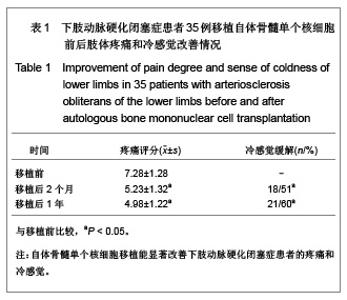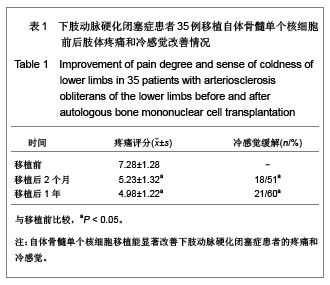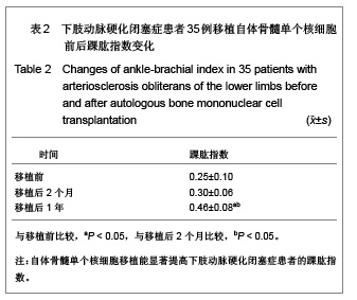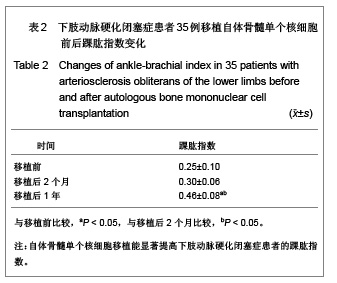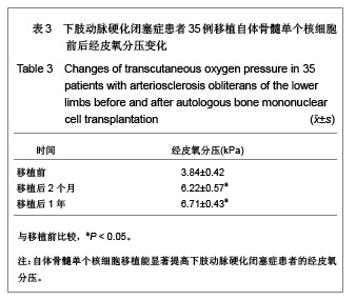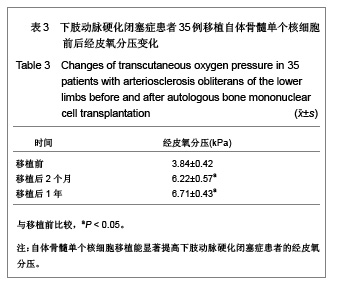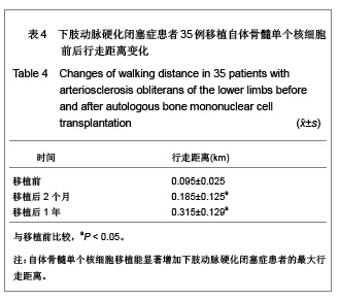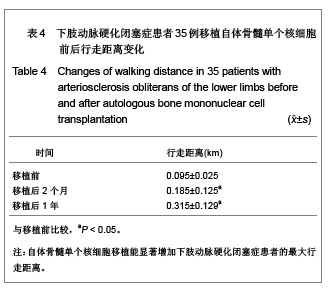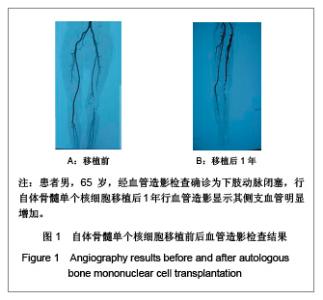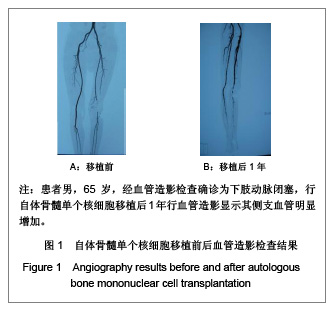| [1] Kirana S, Stratmann B, Lammers D, et al. Wound therapy with autologous bone marrow stem cells in diabetic patients with ischaemia-induced tissue ulcers affecting the lower limbs. Int J Clin Pract. 2007;61(4):690-692.[2] Abarbanell AM, Coffey AC, Fehrenbacher JW, et al. Proinflammatory cytokine effects on mesenchymal stem cell therapy for the ischemic heart. Ann Thorac Surg. 2009; 88(3): 1036-1043.[3] Hoshino J, Ubara Y, Hara S, et al. Quality of life improvement and long-term effects of peripheral blood mononuclear cell transplantation for severe arteriosclerosis obliterans in diabetic patients on dialysis. Circ J. 2007;71(8):1193-1198.[4] Lawall H, Bramlage P, Amann B.Treatment of peripheral arterial disease using stem and progenitor cell therapy. J Vasc Surg. 2011;53(2):445-453.[5] Lian F, Zhu HS, Zhu W, et al. Shanghai Shiyan Dongwu Kexue. 2003;23(2): 67-69,74. 连锋,朱洪生,朱伟,等.猪骨髓间质干细胞体外分离,培养鉴定及向肌细胞转化的探索[J].上海实验动物科学,2003,23(2): 67-69,74.[6] Zhu CJ, Dong JX, Zhang MJ,et al. Zhongguo Zhenjiu. 2009; 29(12):987-992. 朱朝军,董建勋,张美吉,等.经穴注射骨髓间充质干细胞对后肢缺血大鼠血流的影响[J].中国针灸, 2009,29(12):987-992.[7] Freyman T, Polin G, Osman H, et al. A quantitative, randomized study evaluating three methods of mesenchymal stem cell delivery following myocardial infarction. Eur Heart J. 2006;27(9):1114-1122.[8] Zhu CJ, Dong JX, Li J, et al. Preliminary study on the mechanism of acupoint injection of bone marrow mesenchymal stem cells in improving blood flow in the rat of hind limb ischemia. J Tradit Chin Med. 2011;31(3):241-245.[9] Abarbanell AM, Coffey AC, Fehrenbacher JW, et al. Proinflammatory cytokine effects on mesenchymal stem cell therapy for the ischemic heart. Ann Thorac Surg. 2009;88(3): 1036-1043.[10] Murphy MP, Wang H, Patel AN, et al. Allogeneic endometrial regenerative cells: an "Off the shelf solution" for critical limb ischemia. J Transl Med. 2008;6:45.[11] Jonsson TB, Larzon T, Arfvidsson B,et al. Adverse events during treatment of critical limb ischemia with autologous peripheral blood mononuclear cell implant. Int Angiol. 2012; 31(1):77-84.[12] Kirana S, Stratmann B, Prante C, et al. Autologous stem cell therapy in the treatment of limb ischaemia induced chronic tissue ulcers of diabetic foot patients. Int J Clin Pract. 2012; 66(4):384-393.[13] Benoit E, O'Donnell TF Jr, Iafrati MD, et al. The role of amputation as an outcome measure in cellular therapy for critical limb ischemia: implications for clinical trial design. J Transl Med. 2011;9:165.[14] Dubský M, Jirkovská A, Bém R, et al. Treatment of critical limb ischemia and diabetic foot disease by the use of autologous stem cells. Vnitr Lek. 2011;57(5):451-455.[15] Lawall H, Bramlage P, Amann B. Stem cell and progenitor cell therapy in peripheral artery disease. A critical appraisal.Thromb Haemost. 2010;103(4):696-709.[16] Esato K, Hamano K, Li TS, et al. Neovascularization induced by autologous bone marrow cell implantation in peripheral arterial disease.Cell Transplant. 2002;11(8):747-752.[17] Saigawa T, Kato K, Ozawa T, et al. Clinical application of bone marrow implantation in patients with arteriosclerosis obliterans, and the association between efficacy and the number of implanted bone marrow cells.Circ J. 2004;68(12): 1189-1193.[18] Gu YQ. Determination of amputation level in ischaemic lower limbs. ANZ J Surg. 2004;74(1-2):31-33.[19] Huang PP,Li SX,Han MZ,et al. Zhonghua Xueyexue Zazhi. 2003;24(6):308-311. 黄平平,李尚香,韩明哲,等.自体外周血干细胞移植治疗下肢动脉硬化性闭塞症[J].中华血液学杂志,2003,24(6):308-311.[20] Yang XF,Wu YX,Wang HM,et al. Zhonghua Neike Zazhi. 2005; 44(2):95-98. 杨晓凤,吴雁翔,王红梅,等.自体外周血干细胞移植治疗62例缺血性下肢血管病的临床研究[J].中华内科杂志,2005,44(2):95-98.[21] Ho IA, Chan KY, Ng WH, et al. Matrix metalloproteinase 1 is necessary for the migration of human bone marrow-derived mesenchymal stem cells toward human glioma.Stem Cells. 2009;27(6):1366-1375.[22] Traver D, Zon LI.Walking the walk: migration and other common themes in blood and vascular development.Cell. 2002;108(6):731-734.[23] Uemura R, Xu M, Ahmad N, et al. Bone marrow stem cells prevent left ventricular remodeling of ischemic heart through paracrine signaling.Circ Res. 2006;98(11):1414-1421.[24] Pasha Z, Wang Y, Sheikh R, et al. Preconditioning enhances cell survival and differentiation of stem cells during transplantation in infarcted myocardium.Cardiovasc Res. 2008;77(1):134-142.[25] Takamiya M, Okigaki M, Jin D, et al. Granulocyte colony-stimulating factor-mobilized circulating c-Kit+/Flk-1+ progenitor cells regenerate endothelium and inhibit neointimal hyperplasia after vascular injury. Arterioscler Thromb Vasc Biol. 2006;26(4):751-757.[26] Bartsch T, Falke T, Brehm M,et al. Transplantation of autologous adult bone marrow stem cells in patients with severe peripheral arterial occlusion disease. Med Klin (Munich). 2006;101 Suppl 1:195-197.[27] Cobellis G, Botti C, Taddeo A,et al. Successful bone marrow transplantation reveals the lack of endothelial progenitor cells mobilization in a patient with critical limb ischemia: a case report.Transplant Proc. 2010;42(7):2816-2820.[28] Meng J, Yao X, Kang S, et al. ATreatment of ischemic limbs by transplantation of G-CSF stimulated bone marrow cells in diabetic rabbits.Clin Invest Med. 2010;33(3): E174-E180.[29] Lasala GP, Silva JA, Gardner PA, et al.Combination stem cell therapy for the treatment of severe limb ischemia: safety and efficacy analysis.Angiology. 2010;61(6):551-556. |
